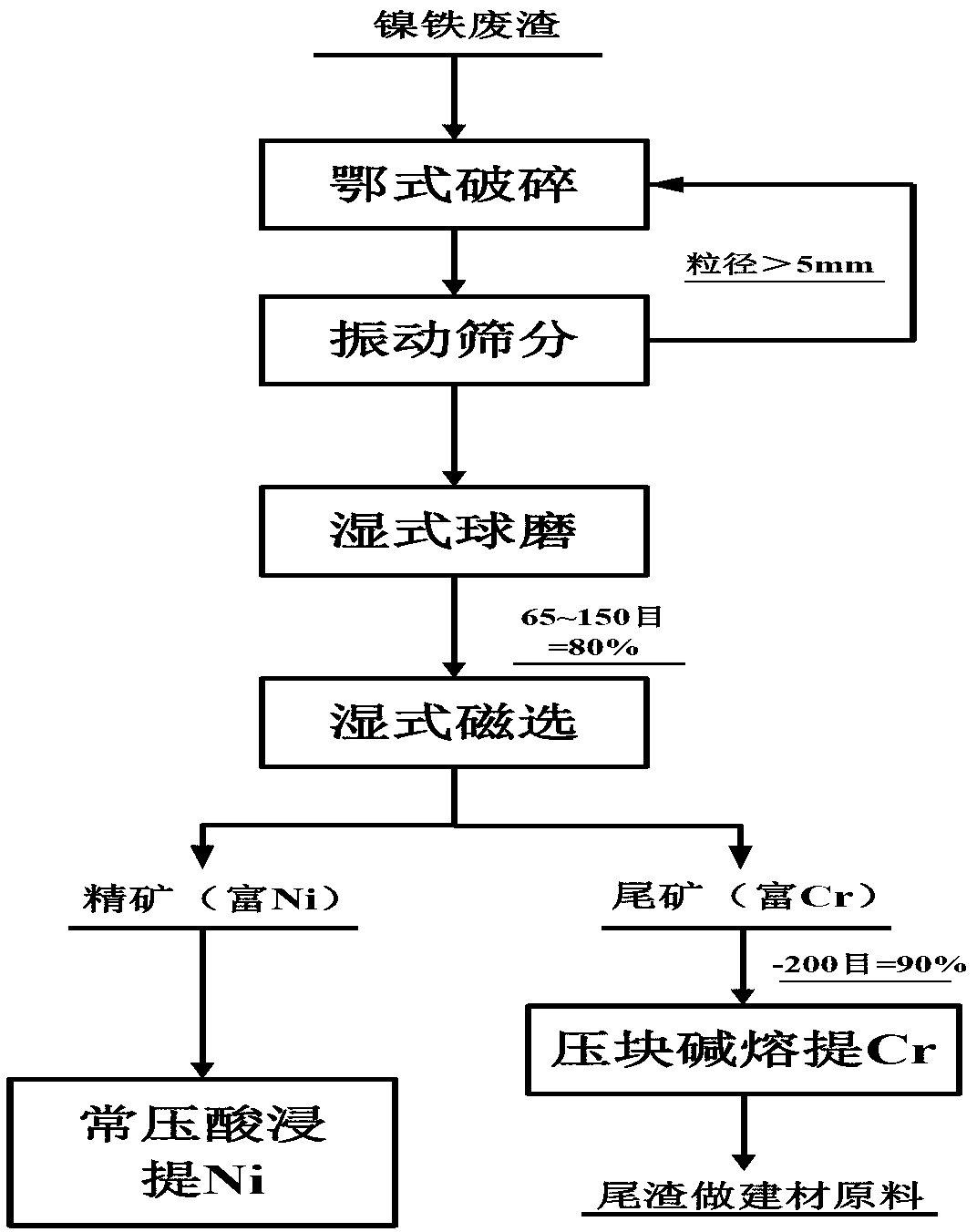Clean production method for treating waste residues of reduction roasting nickel laterite ore to prepare ferronickel
A clean production, laterite nickel ore technology, applied in the field of non-ferrous metal metallurgy, can solve the problems of difficult treatment, heavy pollution, large waste slag discharge, etc., and achieve the effect of eliminating pollution, reducing pollution and realizing comprehensive utilization.
- Summary
- Abstract
- Description
- Claims
- Application Information
AI Technical Summary
Problems solved by technology
Method used
Image
Examples
Embodiment 1
[0035] The raw material is the waste slag obtained by reducing and smelting ferronickel from Indonesian laterite nickel ore, and its main element composition is: Fe 2 o 3 :45.56%, Ni:0.26%, Co:0.012%, MgO:3.37%, Cr:4.55%, Al:3.61%, SiO 2: 10.05%. After jaw crushing, vibrating screening, and wet ball milling (ball milling time 10 minutes), the material with a particle size of 65-150 mesh accounts for more than 80wt% of the total material, and is separated by wet magnetic separation under a magnetic field strength of 2000 gauss to obtain rich Ni-containing magnetic separation concentrate and Cr-rich magnetic separation tailings. Among them, the grade of Ni in the concentrate reaches 3.15%, and the grade of Cr in the tailings reaches 6.02%. The waste slag particles with a particle size greater than 5mm after the above-mentioned vibratory screening are subjected to jaw crushing again.
[0036] Using magnetic separation tailings as raw material, weigh sodium carbonate and taili...
Embodiment 2
[0039] The raw material is the waste slag obtained by reducing and smelting ferronickel from Indonesian laterite nickel ore, and its main element composition is: Fe 2 o 3 :43.16%, Ni:0.33%, Co:0.015%, MgO:4.85%, Cr:6.06%, Al:2.67%, SiO 2 :9.28%. After crushing and ball milling (ball milling time 30min), wet magnetic separation is carried out under the magnetic field strength of 500 Gauss to obtain Ni-rich magnetic separation concentrate and Cr-rich magnetic separation tailings. Among them, the grade of Ni in the concentrate reaches 3.41%, and the grade of Cr in the tailings reaches 6.98%.
[0040] Using magnetic separation tailings as raw materials, weigh sodium hydroxide and tailings according to the proportion of solid alkali ore ratio of 1.5:1, mix them evenly, place the materials in a tablet press, and press under the condition of a pressure of 5Mpa. Block, hold pressure for 10min. Then the pressed sample was put into a corundum crucible and placed in a muffle furnace,...
Embodiment 3
[0043] The raw material is the waste slag obtained by reducing and smelting ferronickel from Indonesian laterite nickel ore, and its main element composition is: Fe 2 o 3 :45.77%, Ni:0.28%, Co:0.010%, MgO:4.01%, Cr:5.86%, Al:2.97%, SiO 2 :8.94%. After crushing and ball milling (ball milling time 60min), wet magnetic separation is carried out under the magnetic field strength of 3000 Gauss to obtain Ni-rich magnetic separation concentrate and Cr-rich magnetic separation tailings. Among them, the grade of Ni in the concentrate reaches 3.68%, and the grade of Cr in the tailings reaches 7.22%.
[0044] Using magnetic separation tailings as raw materials, weigh potassium hydroxide and tailings according to the proportion of solid alkali ore ratio of 1:1, mix them evenly, put the materials in a tablet press, and press them under the condition of a pressure of 10Mpa. Block, hold pressure for 10min. Then the pressed sample was put into a corundum crucible and placed in a muffle fu...
PUM
 Login to View More
Login to View More Abstract
Description
Claims
Application Information
 Login to View More
Login to View More - R&D
- Intellectual Property
- Life Sciences
- Materials
- Tech Scout
- Unparalleled Data Quality
- Higher Quality Content
- 60% Fewer Hallucinations
Browse by: Latest US Patents, China's latest patents, Technical Efficacy Thesaurus, Application Domain, Technology Topic, Popular Technical Reports.
© 2025 PatSnap. All rights reserved.Legal|Privacy policy|Modern Slavery Act Transparency Statement|Sitemap|About US| Contact US: help@patsnap.com

